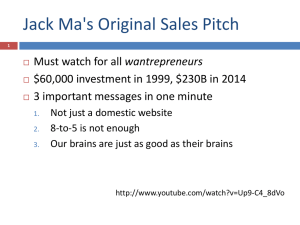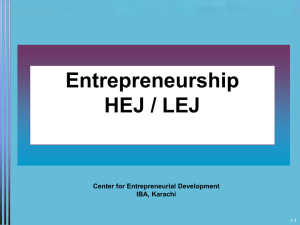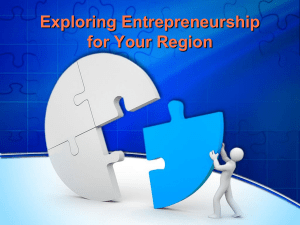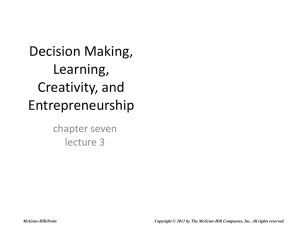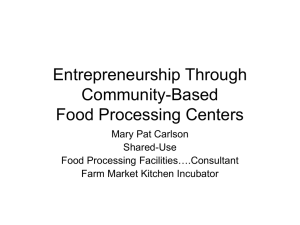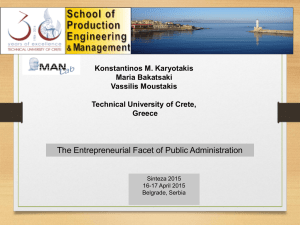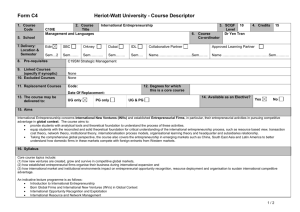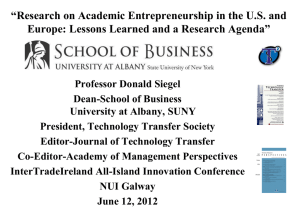Presentation - Rochester Institute of Technology
advertisement
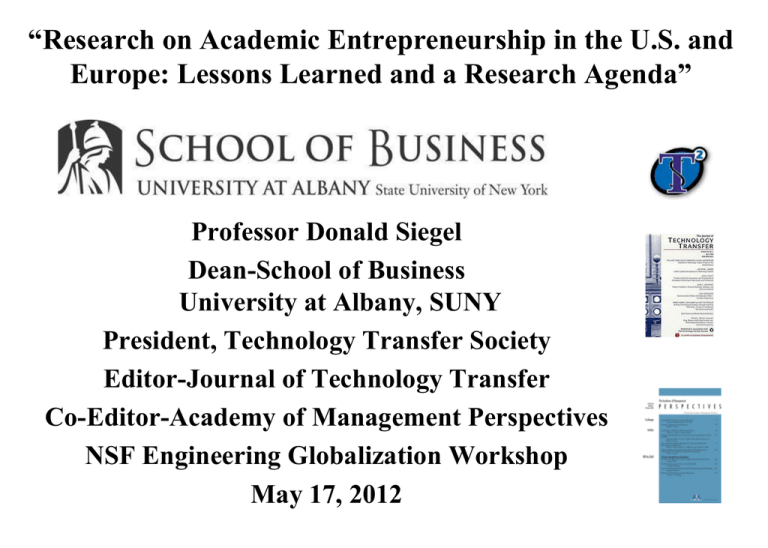
“Research on Academic Entrepreneurship in the U.S. and Europe: Lessons Learned and a Research Agenda” Professor Donald Siegel Dean-School of Business University at Albany, SUNY President, Technology Transfer Society Editor-Journal of Technology Transfer Co-Editor-Academy of Management Perspectives NSF Engineering Globalization Workshop May 17, 2012 Outline Shameless Self-Promotion: Plugs For Technology Transfer Society/Journal of Technology Transfer Summary of Key Research Quantitative and Qualitative Results Lessons Learned Agenda for Additional Research Universities, “GPTs”, and The Creation of New Industries Technology (Primary) Industry Period Developed University Created Electronic University of 1940s Calculator Pennsylvania Computers Fiber 1960s Optics MIT Telecommunications 1970s rDNA 1980s Supercomputing Stanford, California Illinois Biotechnology Internet Sequencing of DNA/ Human Genome Cal Tech, 1990s Project Johns Hopkins Pharmacogenomics 2000s Nanotechnology UAlbany ????? William Baumol-The Free Market Innovation MachineAnalyzing the Growth Miracle of Capitalism Routine/Systematic Innovation-Large Firms Entrepreneurial Innovation-Small Firms “David and Goliath Symbiosis”-Joint Efforts of Individual Entrepreneur and Large Industrial Firm Unprecedented Wealth Creation Siegel (2006)-Universities Increasingly Developing and Nurturing Startups; Also Linking Small and Large Firms Who Engage in Entrepreneurial Innovation Research on Institutions and Agents Involved in Academic Entrepreneurship Agents and Institutions University Scientists Industry Scientists Entrepreneurs Industry-University Cooperative Research Centers University Technology Transfer Offices Science Parks Incubators/Accelerators Firms That Interact With Universities Venture Capital Firms Selected Research Questions How Does the Process of University Technology Commercialization/Academic Entrepreneurship Work? Which Universities “Perform” Best? What is the Role of the TTO? How Should We Measure Performance? Which Factors “Explain” Variation in Relative Performance? (e.g., Incentives, Organizational, and Environmental Factors) Do Incubators/Accelerators and Science Parks Add Value? Interdisciplinary Research on Institutions and Agents Involved in Academic Entrepreneurship Indicators of Output/Performance Invention Disclosures Patents Number of Licensing Agreements Licensing Revenue Research Productivity of Industry Scientists/Firms Research Productivity of University Scientists “Productivity” of Universities in Technology Transfer Start-Up Formation Survival Employment Growth Changes in Stock Prices Key Results for University and Regional Policymakers Bayh-Dole Appears to Have Been “Effective” TTO Staff Add Significant Value Because Scientists Are Not Disclosing Inventions Important for TTOs to Help Academics Study University Entrepreneurship and Technology Transfer Private Universities and Those With Medical Schools Appear to Be Somewhat More Productive Universities Are Becoming More “Strategic” in Technology Transfer (More on that later) –More Heterogeneity and Application of Management Theories to Practice Key Results for University and Regional Policymakers (cont.) Property-based Institutions (Incubators and Science Parks) Appear to Enhance Commercialization Incentives Matter (e.g., Royalty Distribution Formulas), But So Do Organizational Practices and Institutional Policies Universities Increasingly Focusing on the Entrepreneurial Dimension (Evidence Mixed on Success of University Based Startups) Academic Entrepreneurs Are Not Less Productive in Their Academic Research After Commercialization Foreign-Born Scientists Are More Like to Become Academic Entrepreneurs Social Networks of Star Scientists Key for New Firm Creation Key Stylized Facts From Qualitative Research Major Impediments to University Technology Transfer: Informational and Cultural Barriers Between Universities and Firms (Especially for Small Firms) Insufficient Rewards for Faculty Involvement in Technology Transfer at Some Institutions, Especially w.r.t. Entrepreneurial Activity Technology Transfer Office Staffing and Compensation Practices (High Rate of Turnover, Insufficient Business/ Marketing Experience, Possible Need for Incentive Compensation) Education/Training is Needed for Faculty Members, PostDocs, and Graduate Students in the Specifics of the Entrepreneurial Process, the Role of Entrepreneurs, and How to Interact with the Business/Entrepreneurial Community Strategic Implications of University Technology Transfer /Academic Entrepreneurship-Formulation Issues Setting Institutional Goals/Priorities Resources Devoted to University Technology Transfer Choices Regarding Technological Emphasis Strategic Choices Regarding Modes of University Technology Transfer: Licensing Startups Sponsored Research Other Technology Transfer Mechanisms That are Focused More Directly on Stimulating Economic Development (e.g., Incubators and Science Parks) Strategic Implications of University Technology Transfer /Academic Entrepreneurship-Implementation Issues Improving Information Flows Organizational Design/Structure HRM Practices-Staffing/Compensation of TTO Personnel Reward Systems for Faculty Involvement in University Technology Transfer (perhaps including P&T- e.g., 6/06-Texas A&M) Implementation Issues Regarding Modes of University Technology Transfer Different Ways of Structuring Licensing Agreements Academic vs. Surrogate Entrepreneurs Different Ways to Manage University-Based Incubators and Science Parks Personal Reflections Based on Studies of Academic Entrepreneurship We Need More Detailed Exploration of the Nature of the Connection Between Entrepreneurial Firms and the University, Including the Role of Property-Based Institutions (i.e., Incubators/Accelerators & Science/Technology Parks What is The Relationship Between Academic Entrepreneurship and Federal/National Labs (The “Last Frontier” of Technology Transfer) We Need More Detailed Analysis of Technology Transfer Strategy Implementation Personal Reflections Based on Studies of Academic Entrepreneurship (cont.) Strong Need to Enhance Incentives for Faculty Members to Be Engaged in Entrepreneurial Activity (and Perhaps For Successful Ones to Serve As Mentors) Important to Increase Participation/Success of Women & Minorities in Academic Entrepreneurship (as we found in the NRC Evaluation of SBIR) Entrepreneurship Research, Education, and CommunityBased Initiatives Are Key Complements Entrepreneurship As An Academic Field Entrepreneurship (2007) vs. Strategy (1989) Returns to Studying This Topic Are High (e.g., NSFIGERT, Kauffman, development)



